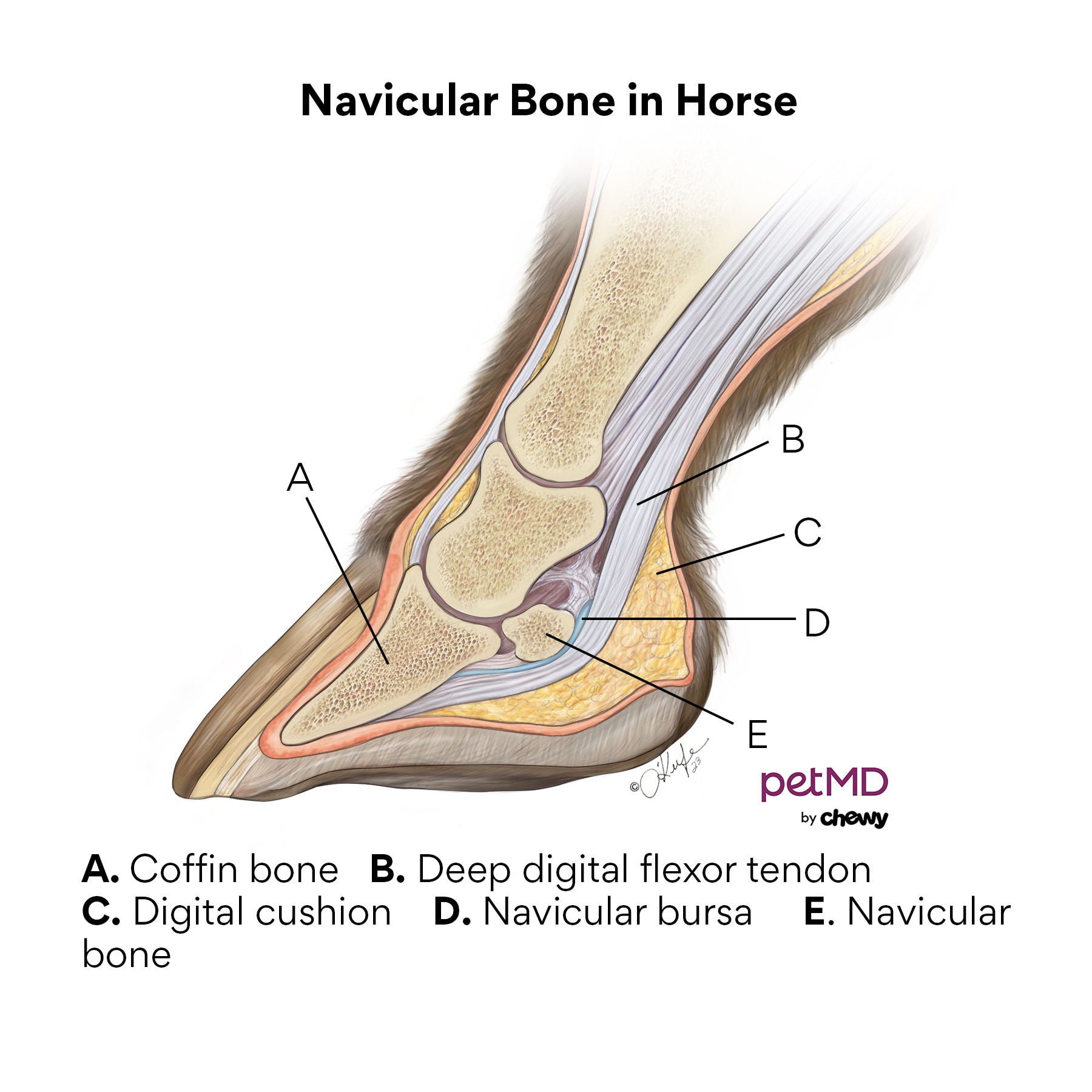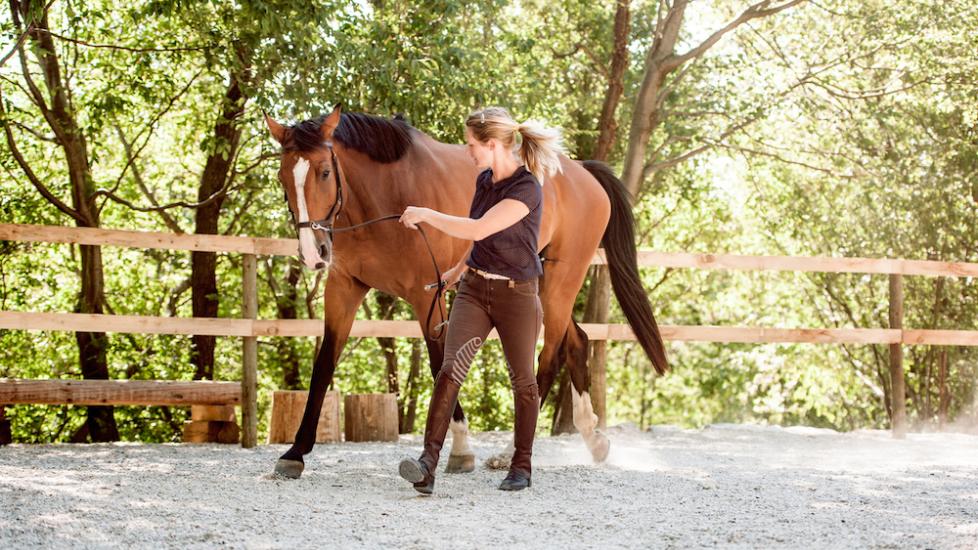Navicular in Horses
What Is Navicular Syndrome in Horses?
Navicular syndrome refers to a dysfunction or disease of structures involved in providing stability and support to the fetlock and foot, including the navicular bone, navicular bursa, and the DDFT.
The navicular bone in horses is a small, flat bone that sits behind the short pastern and coffin bones in the hoof. A small bursa, or pouch of synovial liquid, is located between the navicular bone and the DDFT (deep digital flexor tendon). The DDFT is a long tendon that connects to the muscle above the knee, runs along the back of the fetlock and over the navicular bone, and then inserts into the coffin bone.
In some horses, the navicular bone degenerates over time. When this happens, it’s known as navicular syndrome. This can lead to inflammation in the navicular bursa, and depending on the bony changes that occur, roughening and stress on the DDFT.
Navicular disease is a common cause of chronic front-end lameness that occurs in many athletes, particularly in the Quarter Horse breed. Symptoms typically begin showing in middle-aged horses, and it progresses through the life of the horse. While there is no “cure,” with proper veterinary and hoof care, the athletic career and comfort of your horse can be prolonged.

Symptoms of Navicular Syndrome in Horses
Symptoms of navicular syndrome often start as a minor front end lameness. While both front feet are usually affected, one foot is typically worse than the other. You may notice signs such as:
-
Slight head bob when trotting
-
Shortened stride in the front end
-
Limp worse in tight circles
-
Reluctance to work, or slower than normal
-
Heel pain, or pain on flexion of the fetlock
-
Occasionally pointing of the hoof
-
Lameness worsens if hoof grows long, or if heels become underrun
Causes of Navicular Syndrome in Horses
The exact cause of navicular syndrome is not yet fully understood, but it is thought to be a result of a combination of genetic, environmental, and biomechanical factors.
Environmental factors may include poor hoof care or nutrition, and inadequate exercise. Poor conformation, excessive weight bearing on the front limbs, and poor shoeing practices may also contribute.
How Veterinarians Diagnose Navicular Syndrome in Horses
Diagnosis of navicular syndrome begins with a thorough physical exam by your veterinarian. They will perform a lameness exam, evaluating your horse trotting in straight lines and circles.
They will likely check the foot for pain using hoof testers and localize the lameness using flexion testing. A flexion test puts stress on certain joints—if the horse continues to move soundly, the stressed area is not likely to be involved in the lameness.
Once the area of concern has been localized, the veterinarian will perform a nerve block. This procedure numbs the specific joint space or area.
Often with navicular disease, once the area of concern is blocked, the lameness will “switch feet,” and you’ll see the horse begin having a slight limp in the other front limb. This is because navicular typically affects both feet, one worse than the other.
To determine the extent of involvement of the navicular bone, bursa, DDFT, and other surrounding structures, imaging such as X-rays, ultrasound, and MRIs can be performed. Imaging tests like these will help the veterinarian determine the best treatment route once the level of damage can be assessed.
Treatment of Navicular Syndrome in Horses
Treatment for navicular syndrome aims to reduce pain and inflammation and improve the horse's overall foot health. While there is no treatment for this degenerative process, there are a combination of approaches that can aid in comfort and soundness, such as:
-
Shoeing: Proper shoeing is essential for treating navicular syndrome. The farrier may use special shoes that help to reduce pressure on the navicular bone and DDFT and improve the horse's overall foot balance.
-
Medications: Non-steroidal anti-inflammatory drugs (NSAIDs) such as phenylbutazone or Equioxx® may be used to aid with inflammation and pain in the short term. A medication such as Osphos® can be given intramuscularly every 6–18 months to help aid in the creation and breakdown of bone in the foot. Your veterinarian may recommend other joint medications or supplements.
-
Injections: Corticosteroid, hyaluronic acid, or products such as PRP, IRAP, or Pro-stride injections can be given directly into the affected area to reduce inflammation and pain and try to promote the health of the navicular bursa.
-
Surgery: In severe cases, surgery may be recommended. A procedure called a neurectomy involves cutting the nerves that affect the foot, so your horse will not feel the painful condition as it progresses. This is not always permanent and is not the best course of action in many cases, as daily maintenance and care become much more involved, and your horse may never regain the same level of athleticism.
As this disease gets worse, there may come a point at which none of these methods are continuing to provide your horse comfort, and their quality of life may decline.
Recovery and Management of Navicular Syndrome in Horses
Management of navicular syndrome is an evolving process as advances in medicine occur. While recovery and full treatment are not possible for this degenerative condition, with proper veterinary care, hoof care, and maintenance, your horse can go on to live a comfortable, or even potentially athletic life, for many years to come.
Your horse may need specialized shoes and therapeutic trimming on a strict schedule, along with some of the medication plans listed above. The treatment plan will likely change as your horse becomes more uncomfortable or the disease worsens.
Eventually, navicular syndrome may lead to arthritis, more pronounced lameness, possible weight loss or stress, and other health issues. Prolonged use of anti-inflammatory medications can also cause kidney or gastrointestinal issues.
Prevention of Navicular Syndrome in Horses
While navicular may not be preventable in genetically related cases, preventing navicular syndrome is aimed at promoting foot health, which is possible with proper foot care, good nutrition, and appropriate exercise. Here are some tips to help prevent navicular syndrome:
-
Proper Foot Care: Regular hoof care is essential to keep your horse's feet healthy. The farrier should trim the hooves regularly and shoe the horse properly as guided by veterinary and farrier collaboration based on X-rays and other diagnostic information.
-
Good Nutrition: Providing the horse with a balanced diet that includes adequate protein, vitamins, and minerals is essential to maintain good bone and ligament health.
-
Appropriate Exercise: Avoid overworking your horse, and provide them with adequate rest in between training periods. Avoid extensive training on overly hard or concussive ground.
-
Regular Veterinary Check-ups: Regular check-ups with a veterinarian who is experienced in equine podiatry can help to identify and treat any foot problems before they become severe.
Navicular Syndrome in Horses FAQs
Can a horse recover from navicular?
While navicular is not a curable disease, with proper management, your horse can live a comfortable life with athletic capabilities for a prolonged period.
Can horses with navicular be ridden?
An appropriate exercise and work plan can be developed if the navicular is not severe, your horse is comfortable, and is being managed appropriately with veterinary and farrier care.
What is the prognosis for a horse with navicular?
This depends on the case, as some horses have mild cases that develop slowly and never cause the horse any significant pain, whereas others degenerate more quickly, become very painful, and eventually lose any positive quality of life.
Featured Image: iStock.com/CasarsaGuru
